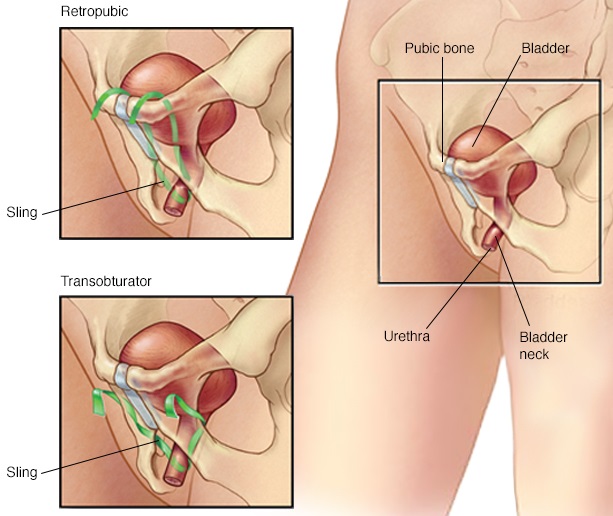 Bladder sling surgery helps women treat urinary incontinence. A polypropylene sling is placed around the urethra to help put it into a more natural position. While this surgery has helped many patients recover from bladder related-issues, there is also a risk that debilitating conditions occur if the sling turns out to be faulty. Male patients find that they need to have additional surgical procedures to remove the device after it has been installed. These risks should be carefully discussed with your doctor before you undergo bladder sling surgery.
Bladder sling surgery helps women treat urinary incontinence. A polypropylene sling is placed around the urethra to help put it into a more natural position. While this surgery has helped many patients recover from bladder related-issues, there is also a risk that debilitating conditions occur if the sling turns out to be faulty. Male patients find that they need to have additional surgical procedures to remove the device after it has been installed. These risks should be carefully discussed with your doctor before you undergo bladder sling surgery.
Bladder slings are installed to prevent sagging of the bladder neck or urethra that is causing difficult urinating. Those with a history of failed surgeries or serious problems with their muscular outlet of the bladder can see improvement when using a bladder sling. Those that have additional complications such as obesity may not be able to undergo other surgical procedures that could help to correct stress incontinence, making a bladder sling their ideal choice for addressing their symptoms.
What to Expect After Bladder Sling Surgery
After undergoing bladder sling surgery you will need to take time to recover and heal:
- Your body will have to undergone a seep incision to insert the sling, which can be painful. You will also need to wear a catheter shortly after your surgery to allow your urine to drain until the urethra has had time to adjust to the new sling.
- In most cases, patients can go home in as few as 2-3 days after their surgery. There will be a 2-4 week recovery period once you arrive home. During this time, strenuous activity should be avoided.
- You may also experience pain during this time, though the amount of pain you experience will vary. This may include cramping in the abdomen. Your doctor should provide medication to help relieve this discomfort.
- Constipation is also a common complaint after experiencing bladder sling surgery. Patients should make a point of increasing their intake of fluids and fibrous foods. Taking a fiber supplement may be necessary to help relieve discomforts. You may also need to schedule a time to relax and take a bowel movement each day to avoid constipation symptoms.
What Risks Do Bladder Sling Surgery Brings?
Bladder slings made from mesh carry a higher risk of side effects:
- These can be painful to insert, causing serious discomforts. Patients may also have trouble passing urine or urinating properly. In extreme cases, a malfunctioning bladder sling can cause internal bleeding or damaging to surrounding organs. If this pain becomes overwhelming, patients may need to undergo several surgeries afterwards to correct this problem.

- In very severe cases, a synthetic bladder sling can cause erosion of nearby organs in the pelvic area. A sling can also puncture nearby organs, causing serious internal damage. The body may also reject the materials used to make the sling, causing inflammation in the organs that come into contact with it. This can cause sexual intercourse to become difficult due to the increased swelling. In either of these cases, surgery will be necessary to reverse the damage the bladder sling has caused.
What If Complications Appear After Inserting Bladder Sling?
The type of complication the patient is experiencing will determine the type of surgery that is necessary to correct the damage. Common complications that result from faulty mesh include erosion or obstruction of the fistula or urethra, damage to the bladder or bowel, or injury to the blood vessels and nerves surrounding the mesh sling. Careful examination will help determine the extent of the damage so necessary surgical procedures can be planned to erase the damage.
If complications occur after a bladder sling has been inserted, reversion surgery may be necessary to remove the device. If the mesh has become damaged or begin to insert itself in another organ it may take several surgeries before all of the mesh can be successfully removed. Your doctor will continue to perform several examinations after your surgery to determine if future treatment is necessary.
